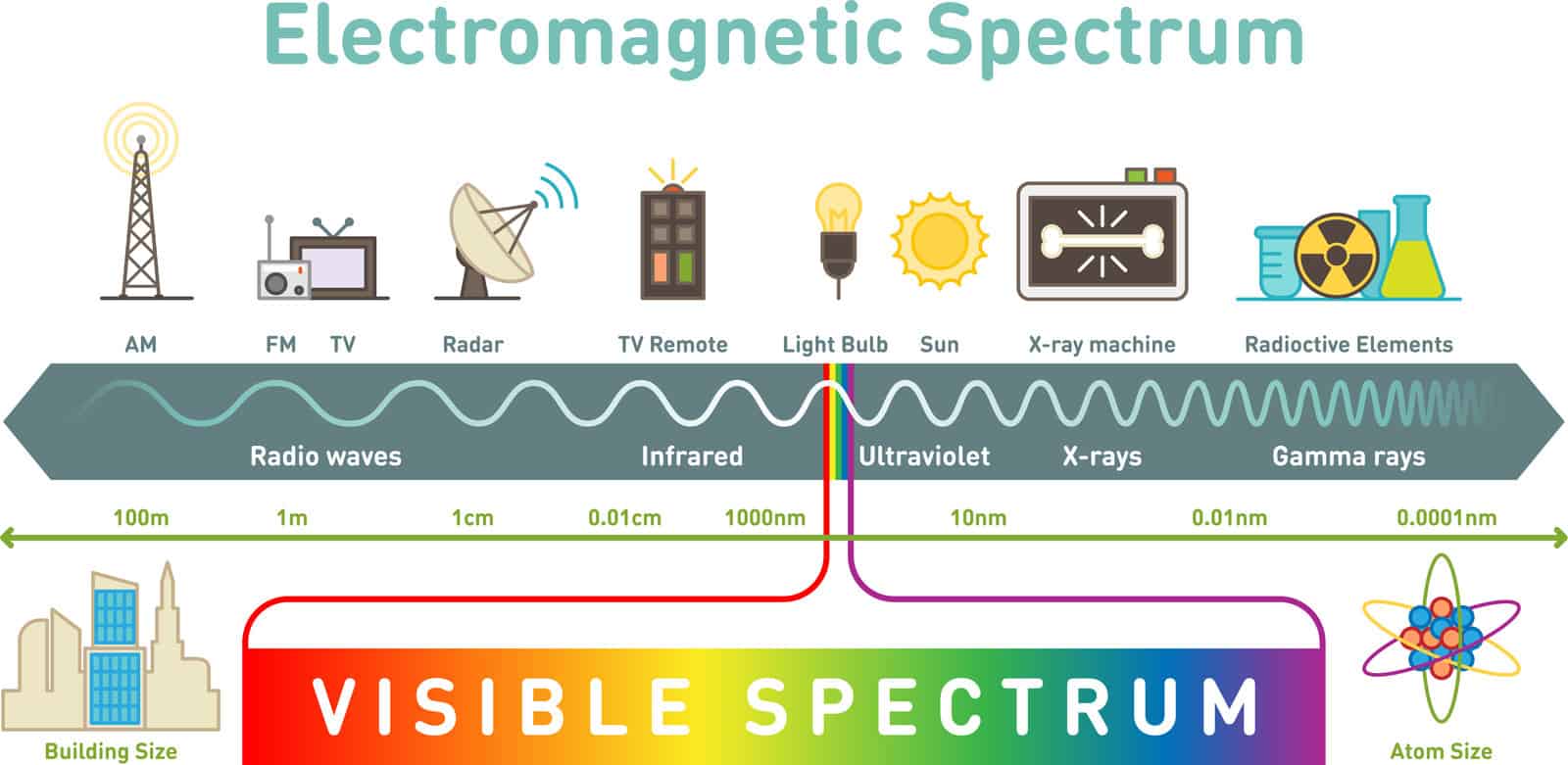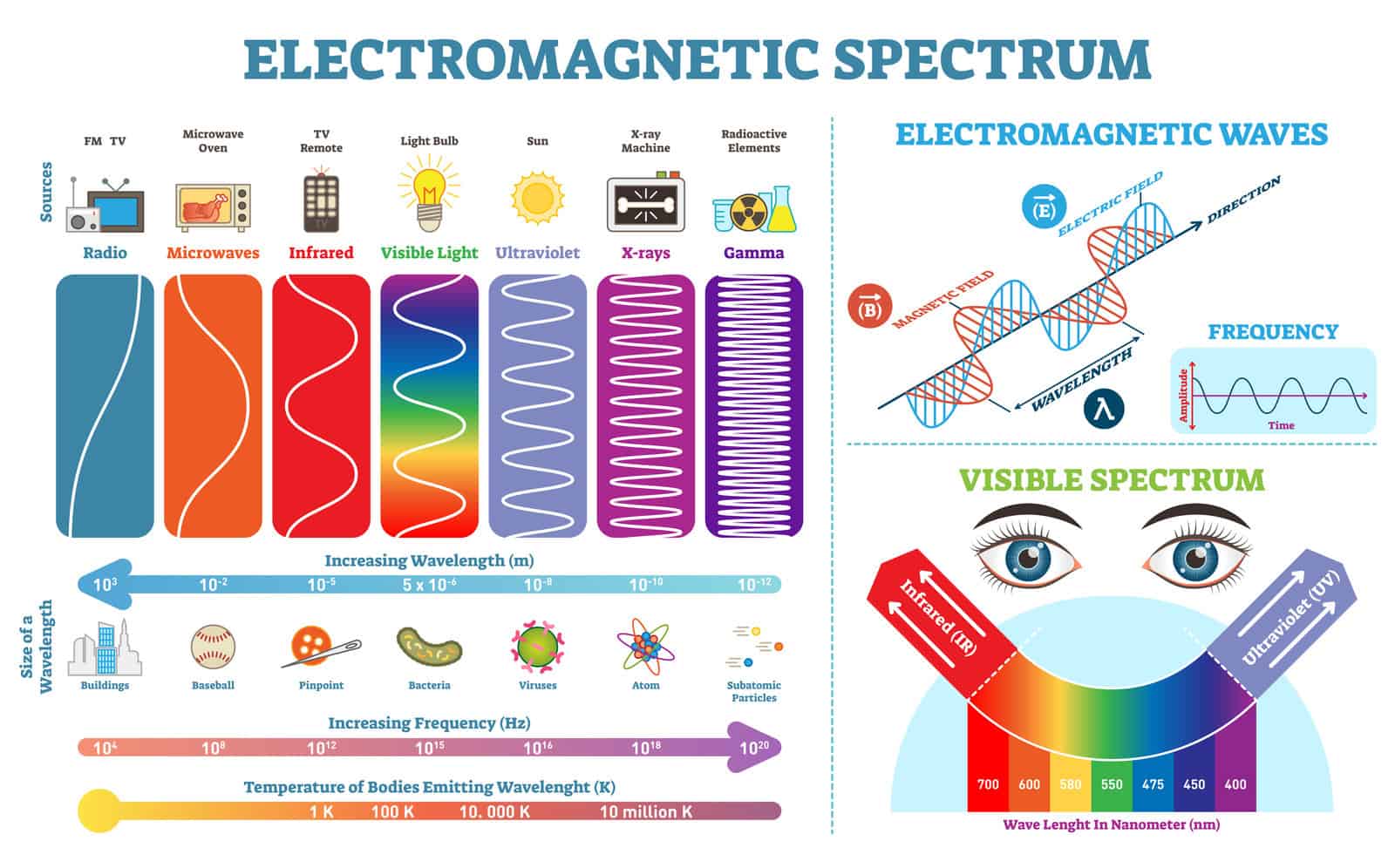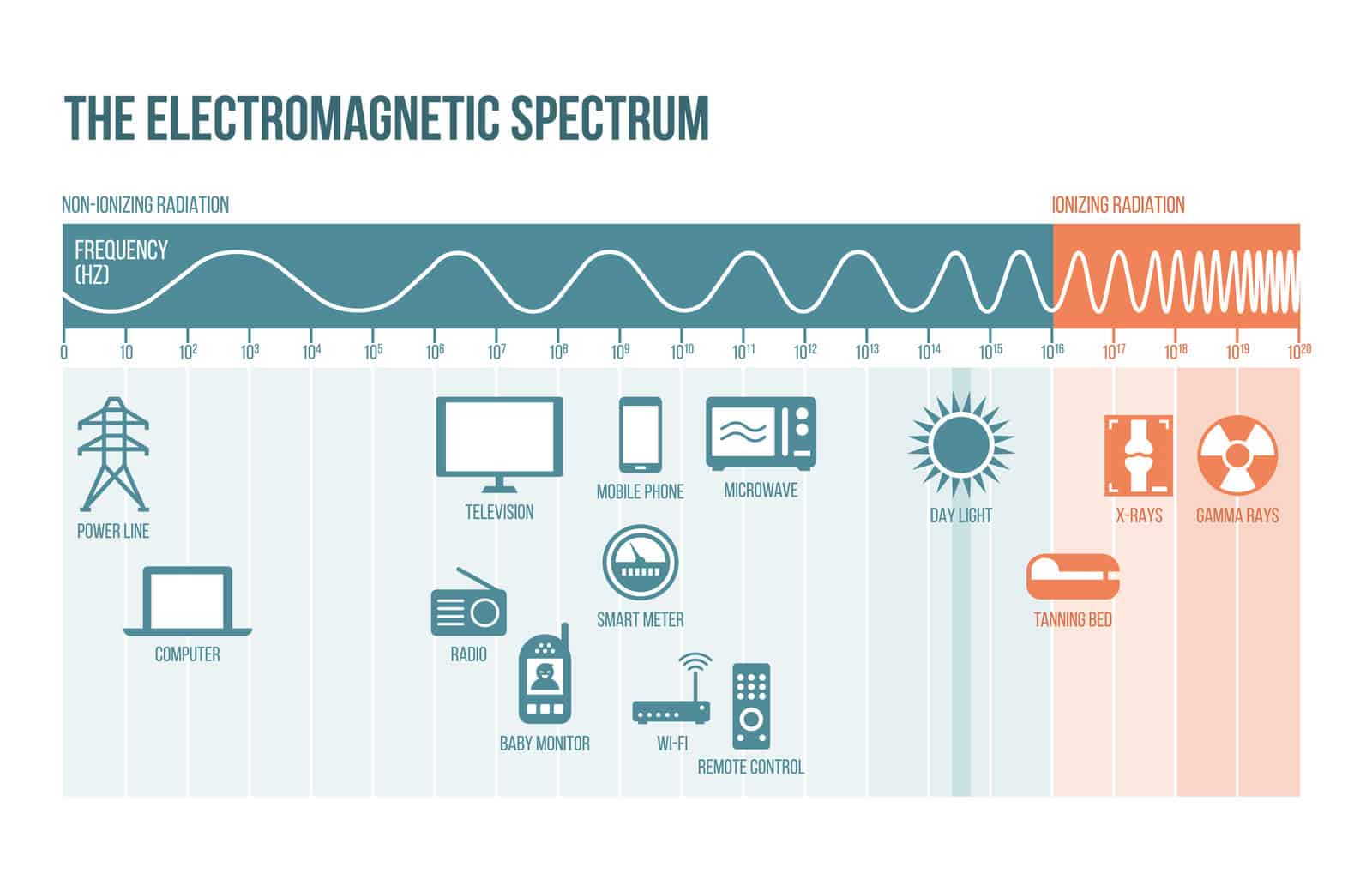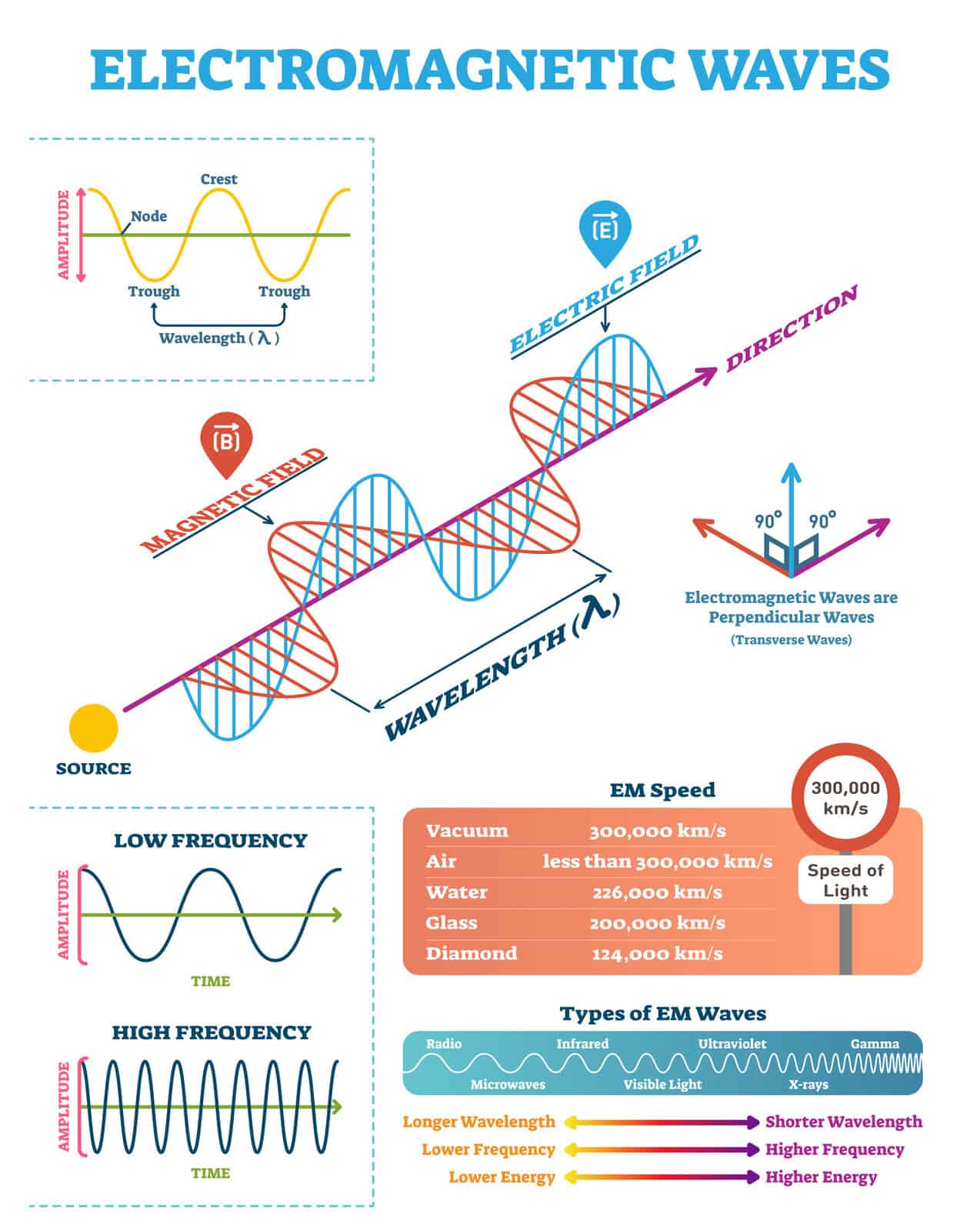
7 Amazing Facts about The Electromagnetic Waves
Table of Contents
Description
Electromagnetic waves are made when an electric field meets a magnetic field. So, we call them “electromagnetic” waves. An electromagnetic wave has both an electric and a magnetic field, but they are at right angles. They also don’t go in the same direction as the EM wave.
In a hoover, the speed of EM waves is always 3.00 x 108 ms-1.
Neither the electric nor magnetic fields can make them move in a different direction. On the other hand, they can show interference or diffraction.
Electromagnetic waves can move through air, solid matter, or even a vacuum.
It can spread from one place to another without the help of a medium. Mechanical waves, like sound or water waves, need something to move through in order to move.
Transverse waves are what EM waves are
This means their height (amplitude) and wavelength (a measure of how far apart the peaks and valleys of two waves are from one another) are used to measure them.
The part of a wave that is the highest is called the “crest,” and the part that is the lowest is called the “trough.” Electromagnetic waves can be broken up into a number of different frequencies.
The electromagnetic spectrum is what we call this.
- Electromagnetic radiation
- Radio waves
- Microwaves
- Infrared
- X-rays
- Gamma rays and so on are all types of EM waves
Types of electromagnetic waves
Gamma rays, X-rays, ultraviolet light, visible light, infrared light, and radio waves are the various parts of the electromagnetic spectrum that are named in order of increasing energy.
The microwave range of the electromagnetic spectrum includes the waves used in microwave ovens.
Examples of electromagnetic waves
Electromagnetic waves: a picture
Electromagnetic waves are made up of things like radio waves, TV waves, and microwaves. The only thing that makes them different is the wavelength.
Electromagnetic waves are made up of two waves that move in opposite directions from each other. One is an electric field that moves back and forth, and the other is a magnetic field that moves back and forth. The Wave moves in a direction against the electric and magnetic fields.
There are three main types of electromagnetic waves:
Even though they are made differently and found differently, they are not really different. Electromagnetic radiation includes radio waves, gamma rays, visible light, and everything else on the electromagnetic spectrum.
This happens most often:
The highest frequency in the electromagnetic spectrum is found in gamma rays. Their frequency is in the range of 1020 to 1022 Hz.
Electromagnetic Waves
Changes in a magnetic field will cause changes in an electric field and vice versa.
Electromagnetic waves are made up of these fields that change. Electromagnetic waves don’t need something to travel through as mechanical waves does.
Electromagnetic (EM) Spectrum
Sun’s range of visible light.
The part of the Sun’s spectrum that we can see. With our eyes, we can only make out a band of the electromagnetic spectrum that is very narrow.
Normal white light is made up of all the colours of the rainbow, from red and orange to blue and purple.
Light comes in many other “colours” that we can’t see.
These include “light” like ultraviolet (UV) and infrared (IR), which humans can’t see.
They also include X-rays, gamma rays, and radio waves, which are less common types of radiation.
The EM spectrum, which stands for the electromagnetic spectrum, is a term for all of these different “colours” of light.
The photons in each part of the electromagnetic (EM) spectrum have their own energy levels, wavelengths, and frequencies.
Gamma rays are the most powerful, have the shortest wavelengths, and travel at the fastest speeds.
On the other hand, radio waves have the least energy, the longest wavelengths, and the lowest frequencies.
All types of EM radiation. The parts of the EM spectrum are called gamma rays, X-rays, ultraviolet radiation, visible light, infrared radiation, and radio waves, from most energy to least. Microwaves, like the ones in microwave ovens, are a part of the EM spectrum’s radio wave section.
How electromagnetic waves work
- Electromagnetic waves are made up of two waves that move in opposite directions from each other.
- One is an electric field that moves back and forth, and the other is a magnetic field that moves back and forth.
- The Wave moves in a direction that goes against the electric and magnetic fields.
- They move in different directions and don’t need a material medium to move. They move at 3 x 108 m/s, which is the speed of light.
The basics:
Electromagnetic waves move in a way that is called “transverse.”
- Waves move by changing the electric and magnetic fields around them so that Both fields are not in the same direction. And in the right way in which the Wave is moving.
- An electromagnetic wave travelling through a hoover cleaner travels at the same speed as, according to the third property. The waves are moving at a speed of 3 x 108 m/s.
- Electromagnetic waves are waves that are not made of matter. They can spread without needing anything physical.
- They agree with the equation c = f. Here, f is the frequency in Hertz and is the length of the Wave in metres. The speed of light is 3 x 108 metres per second, and the product of the wavelength and frequency is a constant c. By looking at the relationship between wavelength, frequency, and the speed of light, we can see that electromagnetic waves will always move at the speed of light, no matter their wavelength or frequency.
- The magnetic field and the oscillating electric field are in the same phase. An electromagnetic wave’s velocity is proportional to the ratio of its electric field strength to its magnetic field strength.
The seven different kinds of electromagnetic waves:
1- Waves that travel through the air
Radio stations send out radio waves, which your radio picks up and turns into your favourite songs. Radio waves can also come from stars and gas in space.
2- Microwaves
Microwave radiation can cook your popcorn in just a few minutes. Astronomers use it to figure out how nearby galaxies are put together.
3- Infrared
The infrared light that our bodies and hot things give off is what night vision goggles pick up. We can use infrared light to map the dust between stars in space.
4- Light you can see
Our eyes detect visible light. Light can be seen coming from fireflies, light bulbs, and the stars.
5- Ultraviolet
Ultraviolet rays come from the Sun, which is why our skin tans and burns. UV radiation is also given off by things in space that are “hot.”
6- X-rays
A dentist uses X-rays to take pictures of your teeth, and airport security uses them to look through your bag. X-rays can also be given off by hot gases in the Universe.
7- Gamma-rays
Gamma-ray imaging is a way for doctors to look inside your body. The Universe is the biggest source of gamma rays of all.
The most dangerous kinds of electromagnetic waves are:
- Gamma rays. People can also be hurt by ultraviolet rays, X-rays, and microwaves.
- The bad things that electromagnetic waves do Electromagnetic waves can cause anxiety, nausea, headaches, fatigue, early ageing, liver spots, and other problems.
- Electromagnetic waves move in all directions.
- The range of electromagnetic waves
The range of all types of electromagnetic (EM) radiation is called the electromagnetic spectrum.
Radiation is energy that moves and spreads out as it goes. For example, the light from a lamp in your house and the radio waves from a radio station are both types of electromagnetic radiation.
- Radiation types include microwaves, infrared, ultraviolet, X-rays, and gamma rays. Are the other types of EM radiation that make up the electromagnetic spectrum.
You know more than you might think about the electromagnetic spectrum.
Even though they are made differently and found differently, they are not really different.
- Electromagnetic radiation includes radio waves, gamma rays, visible light, and everything else on the electromagnetic spectrum.
- Electromagnetic radiation is a stream of massless particles called photons that move in waves at the speed of light. Every photon has a certain amount of energy inside of it. The amount of energy in the photons tells us what kind of radiation it is. In radio waves, the photons have low energies; in microwaves, the photons have slightly more energy than radio waves; in infrared, the photons have even more energy. There is even more energy than infrared photons, visible, ultraviolet, X-rays, and gamma-rays, which have the most energy.
Getting a handle on electromagnetic radiation
You can talk about electromagnetic radiation in terms of its energy, wavelength, or frequency. Hertz are the units used to measure frequency.
Meters are used to measure length. Electron volts are used to measure energy. Each of these three numbers used to describe EM radiation has a precise mathematical relationship with the other two.
Scientists don’t like to use numbers that are bigger or smaller than they need to be. “Two kilometres” is much easier to say and write than “two thousand metres.” Scientists usually use whatever units work best for the type of EM radiation they are studying.
Electromagnetic radiation is a stream of massless particles called photons that move in waves at the speed of light.
Every photon has a certain amount of energy inside of it. The amount of energy in the photons tells us what kind of radiation it is.
Photons in radio waves have low energies, while those in microwaves are slightly more energetic.
Infrared photons have even more energy than infrared photons, visible, ultraviolet, X-rays, and gamma-rays, which have the most energy.
The wavelength, frequency, and energy are all related
- Compare the electromagnetic spectrum’s wavelength, frequency, and amount of energy.
- Scientists don’t like to use numbers that are bigger or smaller than they need to be. “Two kilometres” is much easier to say and write than “two thousand metres.” Scientists usually use whatever units work best for the type of EM radiation they are studying.
- When studying radio waves, astronomers usually Use frequency or wavelength units.
- Most of the electromagnetic radio spectrum lies between 1 centimetre and 1 kilometre (30 GHz to 300 kHz).
- Radio is a very large part of the electromagnetic spectrum.
- Astronomers usually use wavelength to study both infrared and visible light.
- Infrared astronomers measure wavelengths in microns (millionths of a metre), so their part of the electromagnetic spectrum is between 1 and 100 microns. .
- If you measure light in nanometers, violet, blue, green, yellow, orange, and red are the visible spectrum’s visible light colours.
- They are between 400 and 700. (This range is a small part of the electromagnetic spectrum.) This means that the light our eyes can see is only a small part of all the electromagnetic radiation around us.
In the EM spectrum, the wavelengths of ultraviolet, X-ray, and gamma rays are very small. Astronomers studying these parts of the EM spectrum usually talk about photons by their energies, measured in electron volts, instead of their wavelengths (eV). UV light has energies between a few electron volts and about 100 eV. Photons that give off X-rays have energies between 100 eV and 100,000 eV. (or 100 keV). Then, all photons with energies higher than 100 keV are gamma rays.
Why do we send telescopes up into space?
-This shows how far different parts of the electromagnetic spectrum can reach into the air.
Most types of electromagnetic radiation from space can’t get to the surface of the Earth because of the atmosphere.
-This shows how far different parts of the electromagnetic spectrum can travel into the atmosphere before being absorbed.
-Radio waves and light that can be seen don’t reach the surface.
-Most of the electromagnetic radiation from space can’t reach the Earth’s surface. Radio waves, light that can be seen, and even some ultraviolet light can reach sea level.
-By putting telescopes on mountaintops, astronomers can look at some infrared wavelengths. Experiments that use balloons can go up to 35 km above the ground and last for months.
Instruments can be taken above the Earth’s atmosphere on rocket flights, but only for a few minutes before they fall back to Earth.
How an electromagnetic field works:
- Energy is a way to measure the ability to do work. It can take many different forms and change from one to another.
- Batteries and the water behind a dam are examples of things that can hold or store energy. Kinetic energy is shown by things that are moving.
- When charged particles like electrons and protons move, they create electromagnetic fields. These fields carry electromagnetic radiation or light.
- Waves can be electromagnetic or mechanical.
- Mechanical and electromagnetic waves are two of the most important ways energy moves worldwide. Mechanical waves are like waves in the water and sound waves in the air.
- Matter, whether solid, gas, liquid, or plasma, can make mechanical waves when it moves or shakes. A medium is any material that waves can propagate through.
- In a liquid, water waves cause vibrations, and sound waves are made in a gas (air).
- These mechanical waves move through a medium by making the molecules bump into each other like falling dominoes, passing energy from one to the next.
- There is nothing that can carry mechanical waves through space, so sound waves can’t travel there.
Electromagnetic Waves: A Summary
- Static electricity is like the kind of energy that makes your hair stand on end.
- A refrigerator magnet is an example of static magnetism. Changes in a magnetic field will cause changes in an electric field and vice versa.
- Electromagnetic waves are made up of these fields that change.
- Unlike mechanical waves, electromagnetic waves Are not necessarily used as a medium to travel from one location to another.
- Electromagnetic waves can penetrate not only air and solid objects but also empty space.
- A Scottish researcher named James Clerk Maxwell came up with a way to measure electromagnetic fields in the 1860s and 1870s. Of measuring the speed of light.

With a scientific theory to explain electromagnetic waves.
He noticed that electric and magnetic fields could combine to make electromagnetic waves.
He put together what are now called “Maxwell’s Equations” to show how electricity and magnetism work together.
The electromagnetic spectrum: An introduction
How do you define electromagnetic energy?
- Electromagnetic energy moves in waves and has a wide range, from radio waves that are very long to very short gamma rays.
- Only a small part of this spectrum, visible light, can be seen by the human eye.
- A radio picks up a different part of the spectrum, and an x-ray machine uses a still different part.
- NASA’s scientific instruments use the whole spectrum of electromagnetic radiation to investigate our planet, our solar system, and the cosmos beyond.
- You use electromagnetic energy when you tune your radio, watch TV, send a text message, or pop popcorn in a microwave.
- You need this energy every single minute of every single day. Without it, you could not live in the world you know.

Our atmosphere keeps us safe:
- Our Sun is a source of all kinds of energy, and its electromagnetic radiation always hits our atmosphere.
- But the Earth’s atmosphere keeps us safe from higher-energy waves that can be dangerous into being, bring into being, bring to life. Electromagnetic radiations are known as gamma rays, x-rays, and some ultraviolet waves “ionising,” which means they have so much power that they can knock electrons out of atoms.
- When these high-energy waves hit atoms and molecules, they can change them. They can also damage cells in organic matter.
- Sometimes these changes are good, like when radiation is used to kill cancer cells, but sometimes they are bad, like when we get a sunburn.
- Several gases in the Earth’s atmosphere mostly reflect or absorb electromagnetic radiation.
- Water vapour, carbon dioxide, and ozone are some of the most important of these gases.
- Some types of radiation, like visible light, mostly pass through the atmosphere. “Atmospheric windows” are these parts of the electromagnetic spectrum with short enough wavelengths to penetrate the air.
- Some microwaves can even get through clouds, which is why they are the best wavelength for satellite signals.
- Even though our atmosphere is important for preserving Earth’s habitability and the survival of its living organisms, it could be more helpful in studying the sources of high-energy radiation in space.
- To “see” quasars and other high-energy light sources, instruments must be placed high above Earth’s atmosphere, which soaks up energy.
The best way to explain what electromagnetic means:
- Having to do with or causing magnetism that is caused by electricity.
- Magnetism is the ability of an object to draw other objects to it. Physics.
- Electromagnetic can also have to do with the science of how electricity and magnetism work together.
The colour has the most life force:
- Violet light
Violet light has the shortest wavelength, so it has the most energy out of all the colours you can see.
The five things you know about electromagnetic waves:
- These waves can send energy through empty space.
- Energy is carried by electromagnetic waves.
Trough refers to the lowest point of a wave, and the highest part is called the crest.
- Remote controls use waves that are close to the infrared range
- Radiant heat is what far infrared waves are.
- Most energy comes from gamma rays.
The names for electromagnetic waves are:
Electromagnetic waves can be broken up into a number of different frequencies.
The electromagnetic spectrum is what we call this. Radiation of all kinds—radio, microwave, infrared, X, gamma rays, and so on are all types of EM waves.
5 ways electromagnetic energy is used:

-Radio waves are one of them.
– Waves on TV.
– Waves of radar.
– Heat (infrared radiation) (infrared radiation)
– Light.
– Ultraviolet Light (This is what causes Sunburns)
– X-rays (just like the ones you get at the doctor’s office)
– Little waves.
Three kinds of gamma rays are:
Radiotherapy,
irradiating food,
and checking for quality are all examples of things that use gamma waves.
These are the important things about electromagnetic waves:
- In an empty space, these waves move at a speed of 3108 m/s.
- They don’t move away from either an electric or a magnetic field.
- They can show how light interferes or bends.
- They are waves that go across.
Electromagnetic waves travel in all directions, and the electric and magnetic fields are the same size.
No transmission medium is required for electromagnetic waves.
Electromagnetic waves travel at a speed of 3108 m/s in a vacuum.
Electric and magnetic fields carry the same amount of energy in an electromagnetic wave.
Things in your home that emit electromagnetic waves:
Things we use every day that give off radiation
- Power lines and electrical items. Wi-Fi. 5G technology, cell phones, cell phone towers, and antennas. Hand-held lasers and laser pointers. Tanning beds and lamps. Smart metres. Compact fluorescent lamps. Microwave ovens.
- Electromagnetic fields are made by many household items, like low-energy light bulbs, TV and computer screens, electric radiators, and even electric blankets.
- These everyday things give off electric or electromagnetic fields or use them to work.
- Radio waves: a way to talk.
- Microwaves are used to heat things.
- Infrared waves are used for things like imaging and remote control.
- A light that we can see lets us see everything around us.
- Ultraviolet waves help scientists learn about galaxies.
- Electrical gadgets like an electric bell, fan, electric motor, loudspeaker, etc.
Electromagnets are used every day for many different things. Electromagnets, for example, are used in the big cranes in rubbish yards.
Electromagnets are also used in a wide range of electronic and electromechanical devices. Here are some common ways to use it.
Generators, motors, and transformers all use electromagnets.
Electric bells and buzzers
– There are headphones and speakers.
– Valves and relays
– Devices that store data, such as VCRs, sellotape recorders, hard drives, etc.
– An induction cooker
– Locks with magnets
– MRI machines
– Particle accelerators
Spectrometers for mass
Electromagnetism is used in a lot of home appliances. It is the basic principle behind how most home appliances work.
Electromagnets are used in many things around the house, like electric fans, electric doorbells, an induction cookers, magnetic locks, etc.
Electromagnets are also used in the field of medicine. Magnetic Resonance Imaging, short for “MRI scan,” is a machine that uses electromagnets. With the help of electromagnetism, the device can scan all the tiny parts of the human body.
– Used in computer hardware and memory storage devices
The bytes and bits that makeup bytes and bits are used to store data in ebook readers and phones.
Electromagnetism is also at work in the magnetic tape that is part of the computer hardware. Electromagnets were a big part of how VCP and VCR stored data even back in the old days.
– Used in power circuits and communication devices
Electromagnets could have been used to make the phones and cell phones we use to talk to people far away.
The electromagnetic pulses and the way the signals interact make cell phones and phones very useful.
The Mag-Lev trains
Mag-Lev trains are trains that stay in the air with the help of magnets.
This happens because there are big magnets on the bottom of the train and on the tracks, and these magnets push against each other. This means these trains can go very fast, up to 200mph.
So there you go! If someone asks you, “What are magnets used for?” you’ll be able to show them how smart you are.
Don’t forget that.

FAQ
1. What are the different types of electromagnetic waves?
The electromagnetic spectrum consists of various waves categorized by their wavelength and frequency. These include radio waves, microwaves, infrared radiation, visible light, ultraviolet radiation, X-rays, and gamma rays.
2. How do electromagnetic waves impact our lives?
Electromagnetic waves play a crucial role in countless aspects of our daily lives. From the visible light that allows us to see, to radio waves that enable communication and microwaves that heat our food, these waves have countless applications.
3. Are there any dangers associated with electromagnetic waves?
Certain types of electromagnetic waves, like X-rays and gamma rays, carry high energy and can be harmful in excessive exposure. However, understanding the different types and practicing safe usage guidelines can minimize any potential risks.
4. What are the future applications of electromagnetic waves?
Research and development in various fields are constantly exploring new uses for electromagnetic waves. Areas like wireless energy transfer, advanced medical imaging, and even space exploration are potential frontiers for these versatile waves.
5. Where can I learn more about electromagnetic waves?
Numerous resources are available online and in libraries to deepen your understanding of this fascinating topic. Science websites, educational articles, and even textbooks can provide further details and fascinating insights.
Conclusion
The electromagnetic spectrum, although often unseen, weaves an intricate tapestry that shapes our world. From the warmth of the sun to the information transmitted through radio waves, these waves touch every aspect of our lives. Understanding their properties and applications allows us to appreciate their diverse roles and empowers us to utilize them responsibly. By delving deeper into this captivating realm, we unlock a window to the invisible forces that shape our universe and continue to drive innovation and discovery.
Why not subscribe to our LearningMole Library for as little as £1.99 per month to access over 3000 fun educational videos.



Leave a Reply